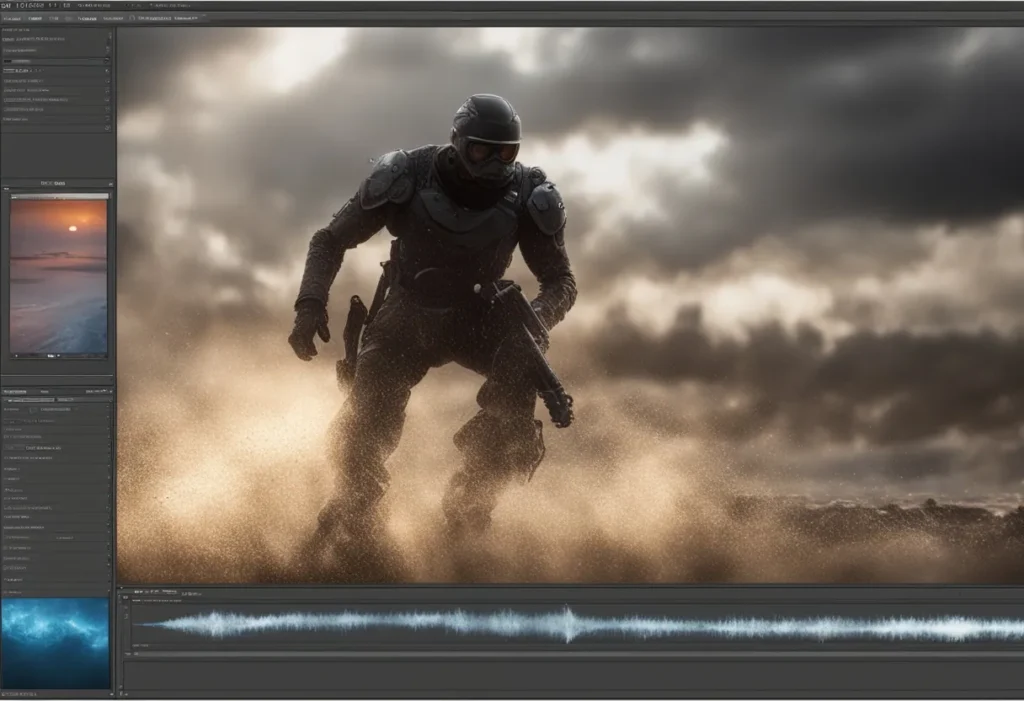Want That Cinematic Look? Here’s How to Get It
Ever watched a movie and thought, “Why does this look so epic, but my videos don’t?”
It’s all about cinematic effects.
The right lighting, colours, movement, and cinematic sound effects transform basic footage into something that feels larger than life.
Let’s break it down.

What Are Cinematic Effects?
Cinematic effects are techniques used in films to create that professional, movie-like feel. These include:
- Lighting – Natural, soft, moody, or high contrast.
- Colour grading – Warm, cool, desaturated, or stylised tones.
- Camera movement – Smooth tracking shots, handheld realism, or drone views.
- Aspect ratio – Widescreen (2.35:1) for a true cinematic look.
- Depth of field – Blurry backgrounds that make subjects pop.
- Cinematic sound effects – The deep, rumbling bass, dramatic swooshes, and tension-building risers.
All of this pulls people in and makes your video feel more like a Hollywood film.
How to Add Cinematic Effects to Your Videos
1. Master Cinematic Lighting
- Natural light? Shoot during golden hour (early morning or late afternoon) for soft, warm tones.
- Artificial light? Use softbox lights or practical lighting (lamps, LED strips) for a pro setup.
- Want drama? Play with shadows and contrast like they do in noir films.
2. Use Cinematic Camera Movements
- Dolly shots – Push in or pull back for a smooth, professional touch.
- Gimbal shots – Stabilised movement for a slick look.
- Handheld – Adds intensity and realism (think action films).
- Slow motion – Makes everything feel epic, especially action sequences.
3. Cinematic Colour Grading
- Use tools like DaVinci Resolve or Adobe Premiere Pro.
- Add a cinematic LUT (pre-made colour presets).
- For a dramatic feel, go for teal and orange tones – Hollywood’s favourite.
4. Aspect Ratio Matters
- Films use 2.35:1 or 2.39:1 for that wide, cinematic feel.
- Try adding black bars on top and bottom in editing to fake it.
5. Cinematic Sound Effects Make or Break a Scene
- Use deep bass hits, risers, whooshes, and tension sounds.
- Websites like Freesound and Zapsplat offer free cinematic sound effects.
- Layer sound effects under dialogue and visuals for extra impact.

How to Add Cinematic Sound Effects to Your Videos
Cinematic sound effects are just as important as visuals. Here’s how to integrate them seamlessly:
1. Choose the Right Sound Effects
- Impacts & Hits – For intense action moments.
- Risers & Whooshes – Build tension and transitions.
- Ambience & Atmosphere – Add depth to scenes.
- Drones & Bass Rumbles – Create a dramatic undertone.
2. Layer Sound Effects Properly
- Don’t just drop in one effect—stack multiple sounds to make it feel natural.
- Example: A car chase could include tire screeches, engine roars, wind rush, and background sirens.
3. Use Sound Design Tools
- Free tools like Audacity allow basic sound editing.
- Pro options like Adobe Audition or Logic Pro help you fine-tune details.
4. Adjust Volume & Panning
- Keep background sounds subtle.
- Make certain effects louder when they match on-screen action.
- Pan sounds left or right for a 3D feel.
5. Download Free Cinematic Sound Effects
- Freesound – Free library of cinematic sounds.
- Zapsplat – Thousands of free sound effects.
- Filmora Sound Effects – Great for beginners.

Cinematic Movie Effects vs. Standard Video Effects
| Feature | Cinematic Movie Effects | Standard Video Effects |
|---|---|---|
| Lighting | Controlled, dramatic | Harsh, inconsistent |
| Colour Grading | Deep, stylised | Natural, basic |
| Camera Movements | Smooth, intentional | Static, shaky |
| Sound Effects | Deep, immersive | Simple, flat |
| Aspect Ratio | Widescreen (2.35:1) | Regular (16:9) |
Free Tools for Cinematic Effects
You don’t need a Hollywood budget to create movie magic. Try these free tools:
- DaVinci Resolve – Pro-level colour grading.
- Freesound – Free cinematic sound effects.
- HitFilm Express – Free VFX and editing software.
- Canva – Quick cinematic text and overlays.
- Zapsplat – Thousands of free cinematic sound effects.
FAQs
1. How do I make my video look cinematic?
Follow these key steps:
- Use soft lighting and avoid harsh shadows.
- Shoot in 24fps for that classic film feel.
- Apply cinematic colour grading (teal & orange works great).
- Add cinematic sound effects to build emotion.
2. What’s the best aspect ratio for cinematic videos?
- 2.35:1 or 2.39:1 (widescreen) is the industry standard.
- If you’re making content for social media, 16:9 still works.
3. Where can I get free cinematic sound effects?
4. What frame rate should I use for cinematic videos?
- 24fps is the go-to for movies.
- For slow-motion, shoot at 60fps or 120fps and slow it down in post.
5. Do I need expensive gear for cinematic effects?
Nope.
- A decent smartphone camera + good lighting + editing can do wonders.
- Add some cinematic LUTs and sound effects, and you’re good to go.
Final Thoughts
Cinematic effects aren’t just for Hollywood.
With the right techniques, anyone can create stunning, movie-like videos.
Start with lighting, movement, sound, and colour grading, and you’ll see the difference.
Now go make something epic.

